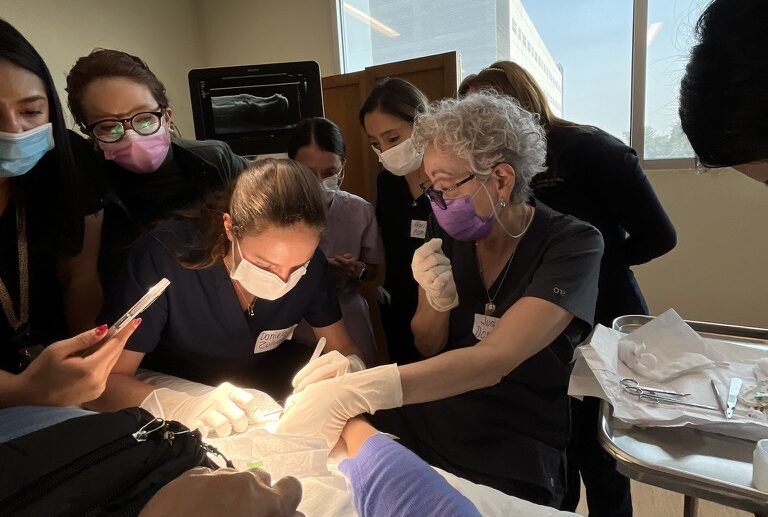dermatology
Granulomas Gone Wild: Update of Rubella as an Evolving Trigger
Dr. Karolyn Wanat presented information about the discovery, diagnosis, and treatment of rubella virus (RuV)-associated granulomas. RuV is a single-stranded RNA virus typically associated with a mild clinical course. It can persist in immune-privileged sites and cause complications, including encephalitis, uveitis, arthritis, and congenital rubella syndrome (CRS). The RuV vaccine was developed because of the…
Bedside Diagnostics for the Dermatologist: Pearls, Pitfalls, Practical Uses
Dr. Karolyn Wanat presented information about microscopy techniques dermatologists can perform at bedside. She used patient cases to demonstrate the utility of these techniques in a variety of settings and noted the similarities among features seen on microscopy and histopathology. Although histopathology may still be needed to confirm the diagnosis, direct microscopy can enable earlier…
When Interferon Interferes: Updates in Childhood Connective Tissue Disease
Dr. Vikash Oza presented information about the diagnosis and treatment of children with connective tissue diseases, including juvenile dermatomyositis (JDM) and chronic cutaneous lupus (CCL). In multidisciplinary settings, dermatologists play an important role in the early identification, treatment, and monitoring of systemic diseases with cutaneous manifestations. Treatment for refractory skin disease in the setting of…
Latest Breakthroughs in Vascular Anomalies
Dr. Erin Mathes shared updates in the evaluation and treatment of vascular anomalies, including infantile hemangioma (IH) and port wine birthmarks (PWB). First, Mathes reviewed the clinical practice guidelines for managing IH. High-risk patients should be referred to a hemangioma specialist. The optimal referral age is 4 weeks. Mathes suggested that clinicians adjust their treatment…
Intriguing Neonatal Cases
Dr. Erin Mathes presented cases that demonstrate neonatal cutaneous processes, including erythroderma, infantile hemangiomas (IH) in preterm infants, solitary infantile myofibromas (IM), infantile malignancies, transverse nasal root veins, and newborn telangiectasias. She highlighted clinical practice gaps and areas for future research. First, Mathes discussed neonatal erythroderma. The differential diagnosis ranges from life-threatening diseases (e.g., severe…
A Champion of Patient Safety and Education
Dr. James Taylor has dedicated his career to the Cleveland Clinic, embodying its mission of patient care, education, and research, the very values for which he received the Dermatology Foundation’s 2025 Practitioner of the Year Honorary Award. Taylor’s career is inextricably linked to the Clinic, where he has worked continually since graduating from the Indiana…
Melanonychia and the Study of Nail Diseases
For 35 years, Judith Domínguez-Cherit, MD, has worked as a dermatologist and assistant professor of dermatology at the Dr. Manuel Gea González General Hospital, the same practice her father, the distinguished dermatologist Luciano Domínguez-Soto, started in 1977. “When I was young, my father took me with him to the hospital,” she said. “I became interested…
The DF Turned 60 Years Young This Year and Will Continue to Revolutionize Dermatology
I find great joy in being part of something larger than myself and watching it grow. It’s much like watching a child mature and thrive on their own. As a long-term supporter, volunteer and Board member, it’s been incredibly exciting to see a small group of dedicated dermatologists work together to further our specialty and…
From Bedside to Bench and Back Again
The turning point in the career of John Harris, MD, PhD, was sudden and an appealing type of serendipity. He had just completed his PhD studying type 1 diabetes in the lab of Dr. Aldo Rossini at UMass Chan Medical School, where he had become fascinated with autoimmunity. But he had grown frustrated that they…
Evidence-Based Vaccine Recommendations for Dermatology Patients
Although vaccines are typically discussed in primary care settings, dermatologists have an important role in vaccine education, especially when prescribing immunosuppressive medications that can increase risk of infections. Infections are more common in patients with chronic skin diseases due to disruption of the protective skin barrier, immune dysregulation associated with disease, and immunosuppressive treatments.




